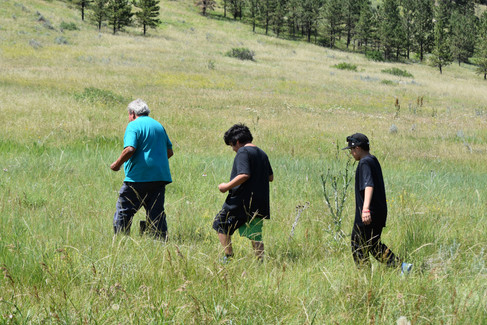By Dr. Allyson Kelley and Dr. Tassy Parker (Seneca Nation citizen, Beaver Clan)
This blog was co-written by AK and Dr. Tassy Parker. Dr. Parker is a long-time mentor, partner, and friend to AKA research and evaluation efforts. Dr. Parker's lifetime commitment to address the structural determinants of health in Indigenous communities is a legacy and path for all of us to follow.
Know the Numbers. Hear the Stories. See the Beauty.
In the United States…
4,000 women die each year from domestic violence.
Children exposed have emotional and behavioral difficulties.
Unborn children face a lifetime of difficulties if they survive.
Families of victims often feel helpless.
October is Domestic Violence Awareness Month, and Indigenous women face some of the highest rates of domestic violence in the United States. At AKA, we get to work with brilliant researchers, aunties, grandmothers, clinicians, and programs to elevate well-being in populations impacted by DV. This is what we know from publications about DV and American Indian/Alaska Native (AI/AN) women.
Numbers help us know things.
47,000 women and girls are killed worldwide from domestic violence.
84 percent of AI/AN women experience some form of violence in their lifetime.
More than half have experienced sexual violence and physical violence by intimate partners. Almost half have been stalked.
10 times more… homicide rates for AI/AN women are more than ten times the national average in some counties and overall is 2.8 times that of White women.
96 percent of perpetrators are non-AI/AN
AI/AN Women experiencing violence are more likely than White women to be physically injured, miss work or school, and be less likely to have access to needed services.
85 percent of AI/AN lesbian, bisexual, and Two-Spirit women experienced sexual assault and 78 percent physical assault.
Stories help us remember.
Joan’s Story
I grew up in the 1960s. We lived on the reservation, and my mom was an enrolled member of the Tribe, and my dad was white. My family was traditional, and my grandparents spoke the ancestral language of our people. Our language was a sign of resilience because my grandparents attended Indian Boarding Schools where they were punished for speaking the language. Boarding Schools stemmed from the 1819 Indian Civilization Fund Act and operated under the “Kill the Indian, Save the Man” policy. Many of us at boarding school were exposed to emotional, sexual, and physical abuse. Together, we attended many ceremonies, and I have fond memories of my early childhood when I played stick games and tended to our community garden. Several generations lived together in our home, with my aunties and grandparents always there for love and support. But my good memories of childhood ended when my grandparents and aunties passed on. At home, my parents fought all the time; they yelled at one another, hit, threatened, and tried to kill. We lived in Tribal housing, and the Dawes/Allotment Act of 1887 took our land in exchange for citizenship (policy). Our neighbors would always call the cops when the fighting began. Cops would show up, but they would never arrest my white dad; we were on the reservation. Today, this might be different because of Section 904 of the Violence Against Women Act (VAWA), which restores special domestic violence criminal jurisdiction to Indian nations over certain non-Indians. I dropped out of school in the 7th grade, my middle school was off the reservation, teachers did not understand my culture, and I had difficulty completing my schoolwork. The 1972 Indian Education Act (IEA) required schools to meet the educational and cultural needs of AI/AN students like me, and later, the 2001 No Child Left Behind Act (NCLB) was designed to hold schools accountable for the educational achievement gap of Native students. But these policies failed me. It is time to create policies and improve conditions so Joan and her family can access safe living conditions, quality education, fair treatment, equity, and justice.

We advocate for policy change to address DV Risk Factors (DVRFS) while addressing structural and institutional inequities (see Parker, Kelley, Maviglia & Redeye, 2024).
There is hope.
If we close our eyes and remember. We can see DV prevention and interventions happening throughout Indian Country and in communities.
Photos help us see beauty.

We see youth asking for help to save our children and restore ceremonies.

We are inspired by the Pueblo of Pojoaque DV walk and the countless speakers and presenters sharing stories of resilience.
We hear the voices of our Indigenous relatives and elders, calling us to address conditions and restore sacred connections to family, culture, and community.

We see Doya Natsu Healing Center dressed in ribbon skirts and shirts, generations of people who are thriving, resilient, and connected to their culture.
We see buffalo roaming in pastures and youth being in nature with elders to learn about medicinal plants that may one day heal them.

We celebrate the completion of Restoring the Sacred Circle Toolkit, knowing that people will see, hear, feel, and learn how to address sexual abuse in their families, communities, and nations.
What can you see when you close your eyes that helps you remember that people, families, and communities are thriving? These images spark memories about what it means to practice prevention.
Kelley, A. & Parker, T. (2024, October 21). Considerations for Addressing Domestic Violence in American Indian Communities: Know the Numbers. Hear the Stories. See the Beauty. Retrieved from: https://www.allysonkelleypllc.com/post/considerations-for-addressing-domestic-violence-in-american-indian-communities











Comments